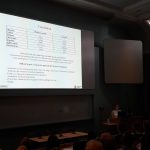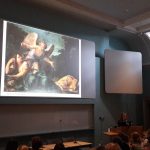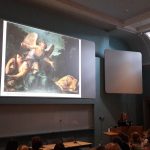On 5 June the students, interns and staff of the HKI attended the 35th Gerry Hedley Student Symposium, hosted by the Courtauld Institute of Art. This annual conference provides an opportunity for the students and interns of the three contributing conservation training programs (the Hamilton Kerr Institute, the Courtauld Institute and Northumbria University) to present their current research projects. This year, the HKI was proud to share the research of two third-year students and two second-year interns.
Amiel Clarke (third-year student) presented her work on the conservation and technical analysis of a painting that was recently re-attributed to the Bolognese artist Marcantonio Franceschini (1649-1729). The painting, entitled Hagar and Ishmael in the Wilderness, is currently undergoing treatment at the HKI and over the last three years, Clarke has had the opportunity to examine the details of the artist’s technique in full. Particularly interesting were the findings offered through x-radiography and infrared reflectography of the painting, which showed significant compositional changes exemplified by alterations made to Hagar’s headdress and neckline. Clarke’s research serves as a textbook example of how the technical analysis of paintings can enhance our understanding of the artist’s process, whilst also aiding in the attribution of artworks.
Our second representative from the HKI, Michaela Straub (third-year student), further demonstrated our tradition of art technological study at the HKI through presenting her work on a fifteenth-century English retable, housed at Leeds Castle, Kent. In her talk, Straub showed us how the practice of reconstruction contributed to her understanding of the panel’s physicality and stages of painting. She reflected on the difficulties she faced when trying to carve and smooth the oak boards that she used for her reconstruction of the painting, whilst also detailing the process she adopted for the application of gold stenciling to the red-painted background. It was easy to see how the trials and errors of reconstructing an old master painting can contribute to a greater appreciation for the level of skill and mastery employed by these medieval craftsmen, and hopefully without sounding biased, I feel that Straub has done exceedingly well with her reconstruction.
The two interns representing the HKI were Camille Polkownik and Sarah Bayliss. Polkownik presented her research on how the physical structure of different qualities of lead white affects the handling of the pigment in oil paint. For her research Polkownik went so far as to make her own lead white through referencing historical recipes. Her success, along with the difficulties she faced in this task, demonstrated the considerable variety in the quality of lead white that is produced using these methods. Polkownik also reflected on the ways in which artists distinguished between the different grades of the pigment, noting that the painters’ scrutiny would have depended largely on empirical knowledge and experience, as opposed to any understanding of the pigment’s crystalline structure.
Sarah Bayliss was the final HKI representative to share her research, which involved the treatment and technical analysis of two panel paintings attributed to the esteemed Tudor period miniaturist, Nicholas Hilliard (c. 1547-1619). The two portraits appear as a pendant pair, featuring Queen Elizabeth I and her ambassador to the French court, Sir Amias Paulet. Bayliss presented the main findings of her in-depth technical study, including the results of dendrochronological examination of the two panels, which pinpoints their origin in France. Through comparing specific painterly traits seen in Hilliard’s miniatures, as well as in the large-scale Pelican and Phoenix portraits of Queen Elizabeth also thought to be by Hilliard, Bayliss was able to put forward a convincing argument for the authorship of these previously unstudied paintings.
The symposium also included talks by five students in their final year of the Postgraduate Diploma course in the Conservation of Easel Paintings at the Courtauld Institute of Art, as well as two students from the MA Conservation of Fine Art programme at Northumbria University. The research presented by the remaining speakers ranged from a study of the influence of metal stearates on the water sensitivity of modern oil paints (Donatella Banti, Courtauld Institute) to the use of gamboge in nineteenth-century watercolour pigment mixtures (Alice Woodward, Northumbria University). Several talks focused on the material study of paintings. Cerys Fry (Courtauld Institute) and Diana Jaskierny (Courtauld Institute) presented their research on selected groups of paintings housed at Knole House in Kent, while Martha Swabey (Northumbria University) shared her study of a series of marouflaged, oil on canvas wall panels in the Music Room of the Brighton Royal Pavilion.
Two talks in particular stood out. Annie Cornwall (Courtauld Institute) presented her informative and original research on the possible methods for cleaning wax-containing paintings by George Stubbs. Cornwall’s study included producing samples based on traditional methods described in eighteenth-century treatises, followed by cleaning tests using free solvents, solvent emulsions, as well as aqueous cleaning solutions developed by Richard Wolbers. The various cleaning reagents were also further tested using agarose gels and Evolon® microfilament textile. After graduating from the Courtauld Institute in July 2017, Cornwall will continue her research into the cleaning of Stubbs’ wax paintings through a postgraduate fellowship at the Yale Centre for British Art. It will be interesting to see the results of her future research, which will no doubt be of use to any practicing restorer aiming to clean a wax-containing painting.
The last presenter to receive mention here is Molly Hughes-Hallett (Courtauld Institute), who shared her research on the applicability of Micro-RTI (reflectance transformation imaging) as a tool for the documentation and conservation of modern and contemporary paintings. RTI is a non-invasive method of analysis that can be used to document and visualize the surface texture of art objects. Hughes-Hallett’s project focused on the applicability of the micro-RTI system developed by Paul Messier, which uses a digital microscope and miniature lighting array to study surface textures in detail over small areas. Case studies were used from the modern and contemporary collection at the Yale University Art Gallery, as well as the Courtauld Gallery and privately owned works in London. The study provided yet another new and interesting example of how advancing technology can be used as an aid to understand and document the condition of paintings. In September 2017, Molly will be joining us at the HKI as a post-graduate intern! We all look forward to hearing more about her research and past experience in person.
All of the research presented at the symposium served to showcase the talented young professionals that emerge from the various training institutes each year. As always, the standard of research was high and showed the ambition and dedication of the students and interns who presented it. The 36th Gerry Hedley Student Symposium will be hosted at Northumbria University in May or June 2018. I look forward to seeing what exciting new research will be presented then.
Emma Jansson, 1st year Post-Graduate Intern
About the author
Emma Jansson graduated from the Courtauld Institute of Art in 2016, having completed the three-year Postgraduate Diploma in the Conservation of Easel Paintings. She also holds a BA in History of Art/Archaeology and Japanese Studies from the School of Oriental and African Studies, University of London. Emma has experience working in both private conservation studios in London and public institutions. Her most recent placements include internships at the Victoria & Albert Museum and the National Maritime Museum in Greenwich, as well as an in situ project at the Houses of Parliament, Westminster Palace. She is also involved in the technical analysis of artworks. Her final-year thesis at the Courtauld Institute focused on the materials and technique of the Impressionist artist Alfred Sisley. Emma is continuing her interest in technical art history at the HKI, where she is involved in several research projects, including a study on the uptake of artificial ultramarine by British artists in the nineteenth century.
To contact Emma: ej309@cam.ac.uk



